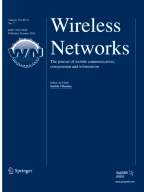Abstract
TCP Westwood (TCPW) is a sender-side modification of the TCP congestion window algorithm that improves upon the performance of TCP Reno in wired as well as wireless networks. The improvement is most significant in wireless networks with lossy links. In fact, TCPW performance is not very sensitive to random errors, while TCP Reno is equally sensitive to random loss and congestion loss and cannot discriminate between them. Hence, the tendency of TCP Reno to overreact to errors. An important distinguishing feature of TCP Westwood with respect to previous wireless TCP “extensions” is that it does not require inspection and/or interception of TCP packets at intermediate (proxy) nodes. Rather, TCPW fully complies with the end-to-end TCP design principle. The key innovative idea is to continuously measure at the TCP sender side the bandwidth used by the connection via monitoring the rate of returning ACKs. The estimate is then used to compute congestion window and slow start threshold after a congestion episode, that is, after three duplicate acknowledgments or after a timeout. The rationale of this strategy is simple: in contrast with TCP Reno which “blindly” halves the congestion window after three duplicate ACKs, TCP Westwood attempts to select a slow start threshold and a congestion window which are consistent with the effective bandwidth used at the time congestion is experienced. We call this mechanism faster recovery. The proposed mechanism is particularly effective over wireless links where sporadic losses due to radio channel problems are often misinterpreted as a symptom of congestion by current TCP schemes and thus lead to an unnecessary window reduction. Experimental studies reveal improvements in throughput performance, as well as in fairness. In addition, friendliness with TCP Reno was observed in a set of experiments showing that TCP Reno connections are not starved by TCPW connections. Most importantly, TCPW is extremely effective in mixed wired and wireless networks where throughput improvements of up to 550% are observed. Finally, TCPW performs almost as well as localized link layer approaches such as the popular Snoop scheme, without incurring the overhead of a specialized link layer protocol.
Similar content being viewed by others
References
A.A. Abouzeid, S. Roy and M. Azizoglu, Stochastic modeling of TCP over lossy link, in: INFOCOM 2000, Tel Aviv, Israel (March 2000).
K.J. Aström and B. Wittenmark, Computer controlled systems (Prentice Hall, Englewood Cliffs, NJ, 1997).
H. Balakrishnan, V.N. Padmanabhan, S. Seshan and R.H. Katz, A comparison of mechanisms for improving TCP performance over wireless links, IEEE/ACM Transactions on Networking (December 1997).
H. Balakrishnan, S. Seshan, E. Amir and R.H. Katz, Improving TCP/IP performance over wireless networks, in: MOBICOM'95, Berkeley, CA (November 1995).
H. Balakrishnan and R.H. Katz, Explicit loss notification and wireless web performance, in: Proceedings of IEEE GLOBECOM'98 Internet Mini-Conference, Sydney, Australia (November 1998).
T. Bonald, Comparison of TCP Reno and TCP Vegas: Efficiency and fairness, in: Proceedings of PERFORMANCE'99,Istanbul, Turkey (October 1999).
C. Casetti, M. Gerla, S. Lee, S. Mascolo and M. Sanadidi, TCP with faster recovery, in: MILCOM 2000, Los Angeles, CA (October 2000).
D. Clark, The design philosophy of the DARPA Internet protocols, in: Proceedings of SIGCOMM'88, ACM Computer Communication Review 18(4) (1988) 106–114.
M. Gerla, R. Lo Cigno, S. Mascolo and W. Weng, Generalized window advertising for TCP congestion control, CSD-TR 990012, UCLA, CA (February 1999).
M. Gerla, W. Weng and R. Cigno, Bandwidth feedback control of TCP and real time sources in the Internet, in: GLOBECOM'2000, San Francisco, CA (November 2000).
T. Henderson, Satellite transport protocol specification, Technical report, University of California, Berkeley (1999).
B.S. Davies and L.L. Peterson, Computer Networks: A Systems Approach, 2nd ed. (Morgan Kaufman, 1999).
V. Jacobson, Congestion avoidance and control, ACM Computer Communications Review 18(4) (August 1988) 314–329.
J. Kurose and K. Ross, Computer Networking: A Top-Down Approach Featuring the Internet (Addison Wesley, 2000).
S.Q. Li and C. Hwang, Link capacity allocation and network control by filtered input rate in high speed networks, IEEE/ACM Transactions on Networking 3(1) (February 1995) 10–25.
M. Mathis, J. Mahdavi, S. Floyd and A. Romanow, TCP selective acknowledgement options, RFC 2018 (April 1996).
D. Mitzel, Overview of 2000 IAB Wireless Internetworking Workshop, RFC 3002 (2000).
W.R. Stevens, TCP/IP Illustrated, Vol. 1 (Addison Wesley, Reading, MA, 1994).
ns-2 network simulator, Version 2, LBL, http://www-mash.cs. berkeley.edu/ns
TCP Westwood modules for ns-2, http://www.telematics. polito.it/casetti/tcp-westwood
S. Keshav, A control-theoretic approach to flow control, in: Proceedings of ACM SIGCOMM 1991 (September 1991).
Author information
Authors and Affiliations
Rights and permissions
About this article
Cite this article
Casetti, C., Gerla, M., Mascolo, S. et al. TCP Westwood: End-to-End Congestion Control for Wired/Wireless Networks. Wireless Networks 8, 467–479 (2002). https://doi.org/10.1023/A:1016590112381
Issue Date:
DOI: https://doi.org/10.1023/A:1016590112381
